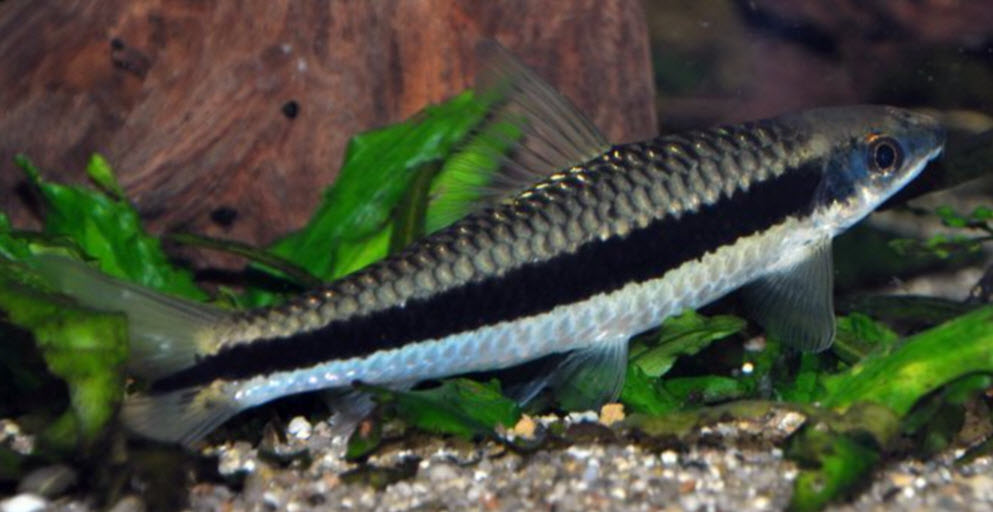A very good way to treat nuisance algae is by using “algae eaters”. These include sucker catfish such as bristlenose catfish (ancistrus), otocinclus, flying foxes (Epalzeorhynchos kalopterus), Silver Flying Fox (Crossocheilus reticulates) and Siamese algae eaters (Crossocheilus siamensis). Black mollies and redline sharks also eat algae. Shrimp and snails also eat algae. These can be effective tools to control algae.
Note we decidedly do not recommend the Chinese algae eaters (Gyrinocheilus aymonieri). The Chinese algae eater only gets to five inches but gets downright vicious in its mature stage in my experience, especially with angelfish. And it only eats algae till it is about three inches long.

Nor do we recommend the common pleco. Common pleco get to two feet over the span of several years so they typically are not suitable for the aquarium.

Note Otocinclus can be difficult. They are an Amazon fish which needs to be in schools of at least six fish and likes very well aerated water that is very clean and bacteria free.

Siamese algae eaters, flying foxes, silver flying foxes and Bristlenose pleco all get to be about five to six inches long at maturity and are probably the best all around algae eaters.
Siamese algae eaters are a little different when it comes to numbers. It is fine as a single specimen as an adult. Alternatively it can be in a school of at least 5 individuals where the numbers spread out the inter-species aggression. If it is in a group of 2 to 4 adult aggression between the Siamese algae eaters can be a problem.

The silver flying fox is very similar to the Siamese algae eater but looks entirely different.

Flying Foxes look very much like Siamese algae eaters and are often sold as Siamese algae eaters. but adult flying foxes can be very territorial and they tend to stop eating algae. They can be differentiated from Siamese algae eaters by the fact that their black bar doesn’t extend into the tail.

The ancistrus bristlenose plecos are great algae eaters that typically hide during the day and come out at night to eat algae. Only the males have the bristles. They do not school but are very peaceful.

Snails eat algae, but they also can proliferate at an incredible rate. The nerite snail is an exception. It eats lots of algae and doesn’t reproduce in the aquarium (needs brackish water for eggs to hatch). But note that the nerite snail leaves white eggs all over the aquarium. Even though the eggs never hatch they don’t look too good in an aquarium.

Shrimp also eat algae. Unfortunately lot of fish love to dine on shrimp. But if one has smaller fish like guppies, small danios and small rasboras, shrimp work well as algae eaters.


There is a myth to the effect that plecos require wood in their diet. It is not true. Plecos, and all sucker mouthed algae eaters including snails, only vacuum wood of all the algae (technically its periphyton). The cellulose of the wood is penetrated in a thin layer by bacteria and fungi in the periphyton. The sucker mouthed algae eaters suck off considerable amounts of cellulose as they eat the periphyton.
The algae eaters do not digest the cellulose (they can’t digest it!) and expel it from their bodies as unsightly long strings of feces. This results in the wood gradually disappearing and a considerable increase in bioload to the aquarium. The combination of any sort of wood with sucker mouthed algae eaters requires added volume of biomedia.
Note this wood cellulose also creates a lot more “brown gunk” as mulm in the aquarium and as floc in the filter. This is due to something called the carbon nitrogen ratio. This can considerably increase the cleaning requirements in the aquarium.
Note that there are thousands of species of algae. Some of these species produce chemicals which some fish will not eat. So sometimes the fish approach isn’t successful. But there is no way to predict which fish will eat which algae, although all sorts of websites try to do just this. Note I have yet to find a species of algae which snails won’t eat but I’m sure there is one out there.

More Information on Controlling Algae
There is a lot more information on how to control algae in these links:
16.2. Controlling Algae in the Aquarium
16.2.1. Controlling Algae in the Fish Only Aquarium
16.2.2. Controlling Algae in the “High-Tech” Planted Aquarium
16.2.3. Controlling Algae in the “Low-Tech” Planted Aquarium


